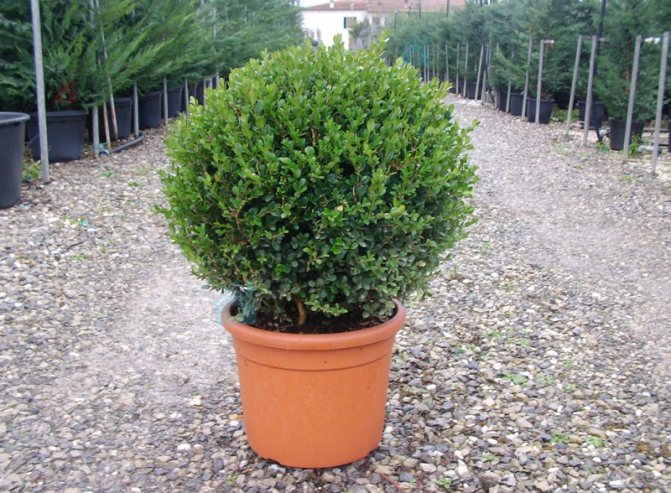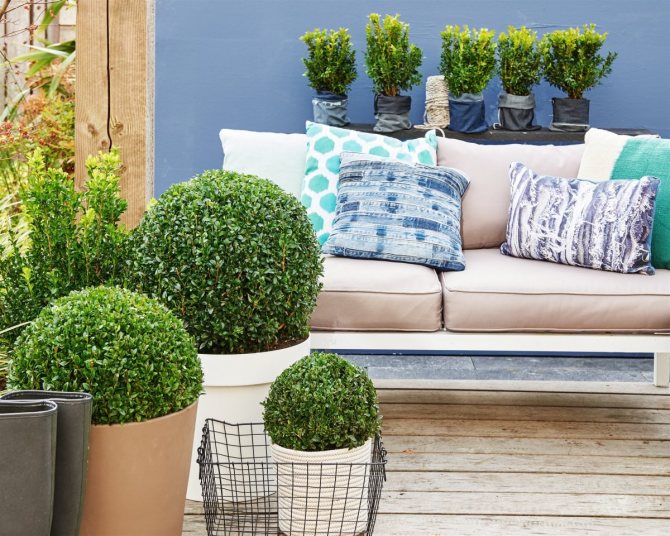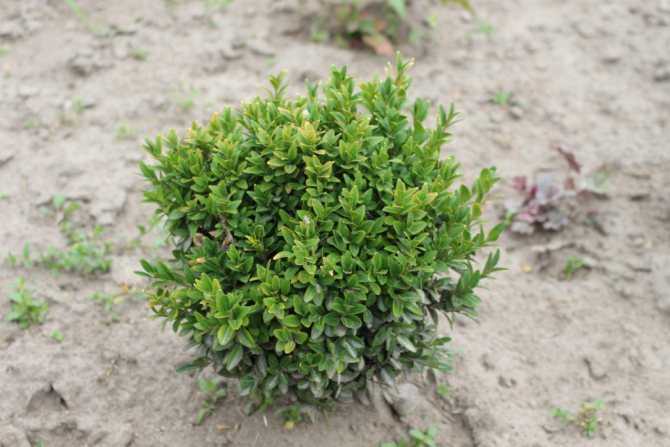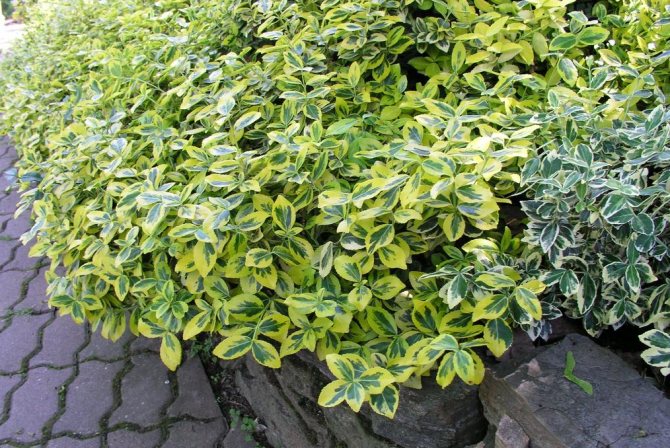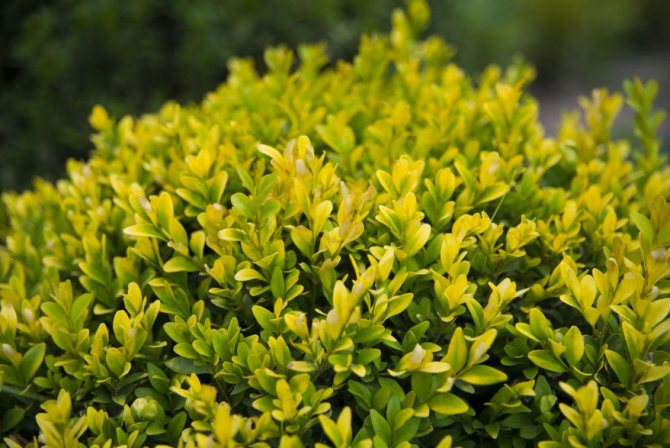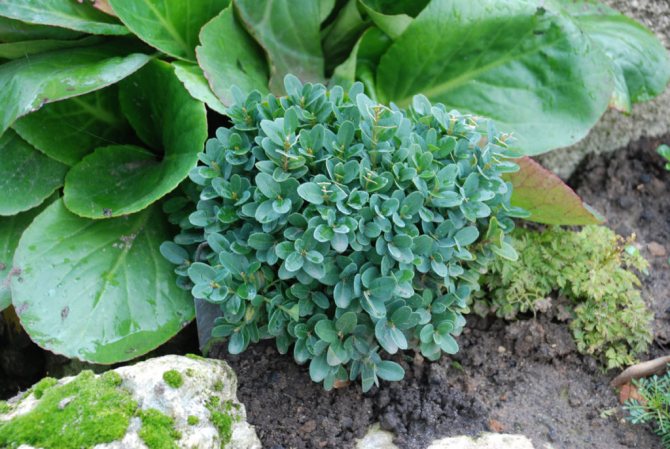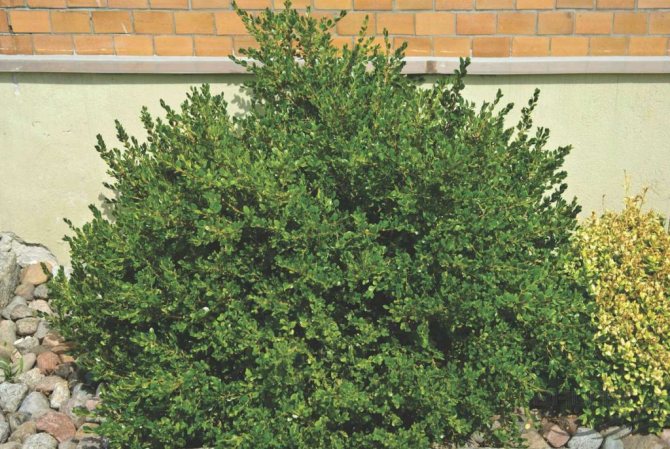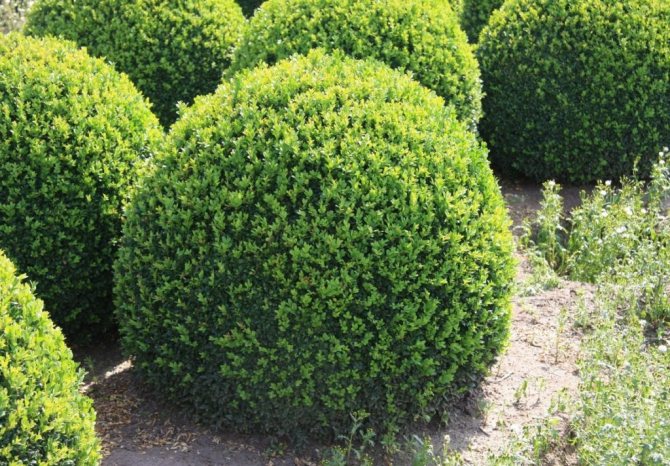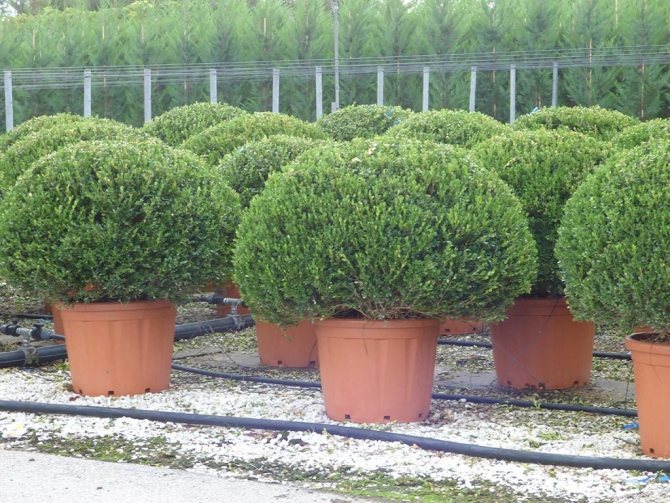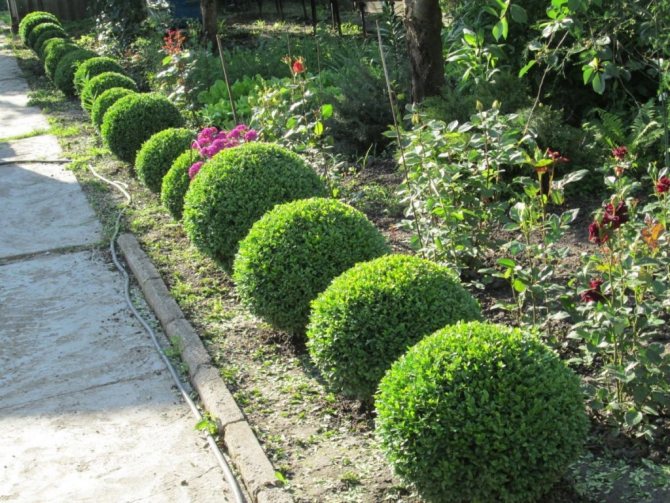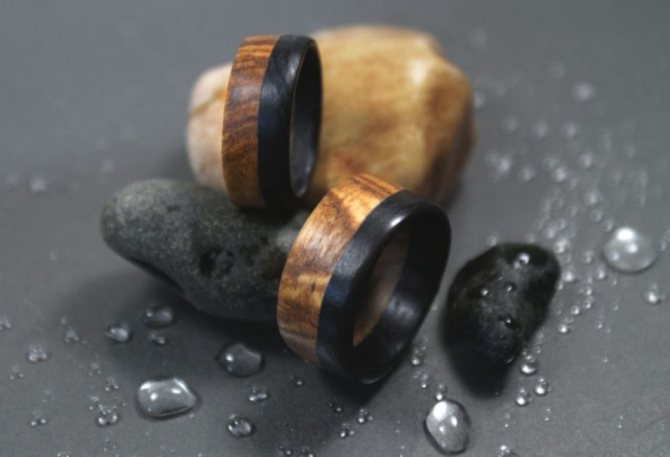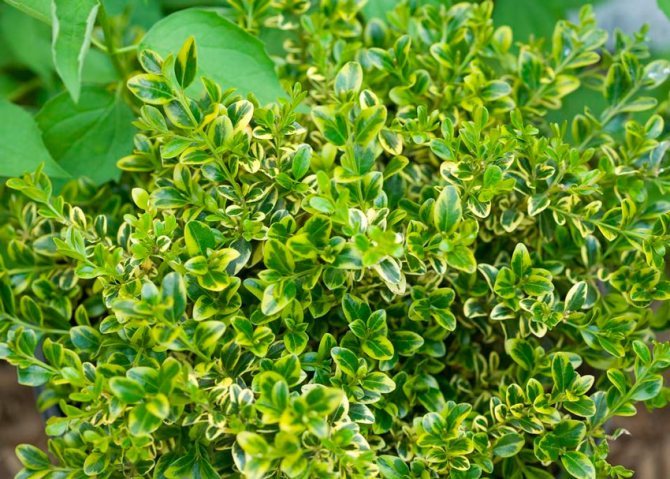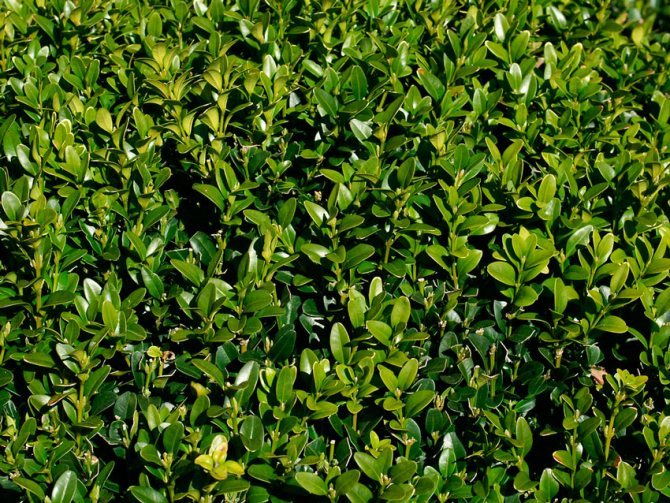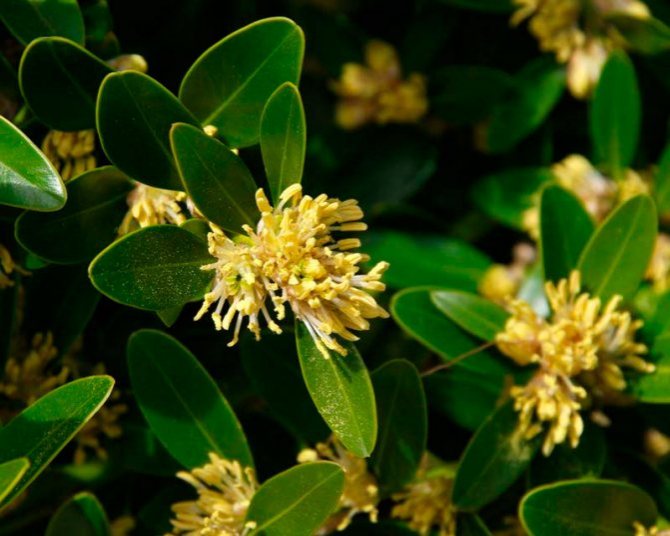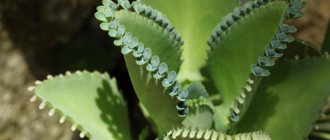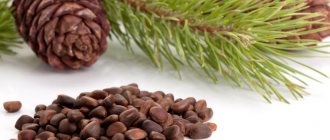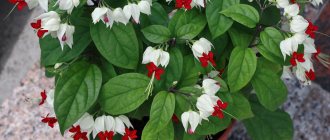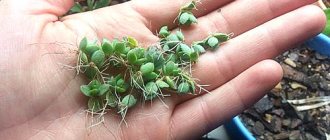Caring for boxwood at home
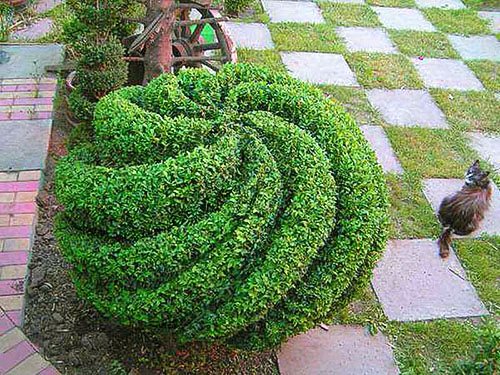
Forming a dense, easy-to-cut and shaping crown, boxwood is one of the favorite plants of landscape designers. On the basis of this evergreen shrub with a dense compact crown and small leaves, not only green borders and living walls are created, but also amazing sculptural compositions.
Interest in culture today is greater than ever. What are the plant's requirements for keeping conditions, and how to care for boxwood so that the plant will delight for a long time with the brilliance of foliage and perfection of form?
In nature, there are more than four dozen boxwood species growing in the Mediterranean countries, in Southeast Asia and India, as well as in Africa and Madagascar.
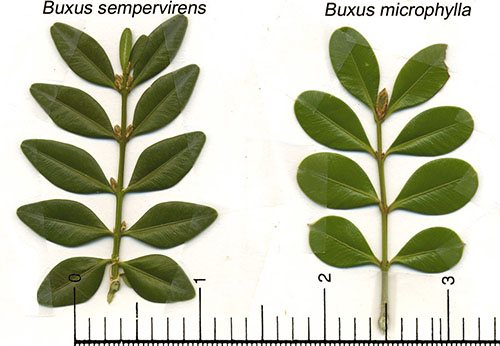

On the territory of Russia, there are two wild-growing types of boxwood: Colchis and Hyrcanian.
The most famous cultivated plant of this vast family is the evergreen boxwood, followed by the small-leaved and Balearic boxwood. These species are used in landscaping cities and parks, and are also grown as indoor crops. Garland's whimsical boxwood is used to create miniature bonsai.
Description of the appearance of the axle box, distribution
In the wild, buxus reaches 12 meters, and the bushes grow up to 2 meters high.


Small leaves are rounded and opposite. They are dense, leathery to the touch. The flowers are small, without petals, and look absolutely nondescript, but fragrant. After pollination, a fruit is formed - a box, which, after ripening, begins to crack, which leads to the scattering of seeds.
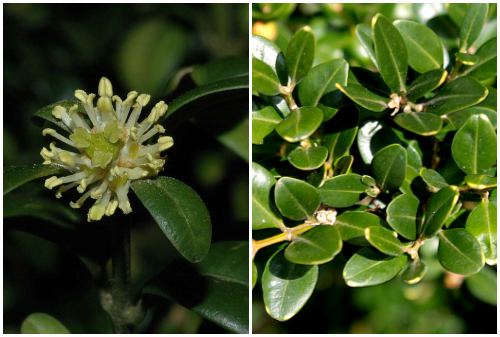

The culture is a good honey plant, but because of its toxicity, honey is not consumed.
Plants can live in almost any conditions: among shrubs, forest edges, in clearings, stony placers, shady deciduous forests. That is, he needs a soil with a slightly acidic reaction.
The habitat is quite diverse - these are the forest-steppes of Africa and Madagascar, Southern Europe, Asia, South and Central America. By the way, American species are the tallest, some specimens reach 20 meters in height.
Growing boxwood and caring for it at home
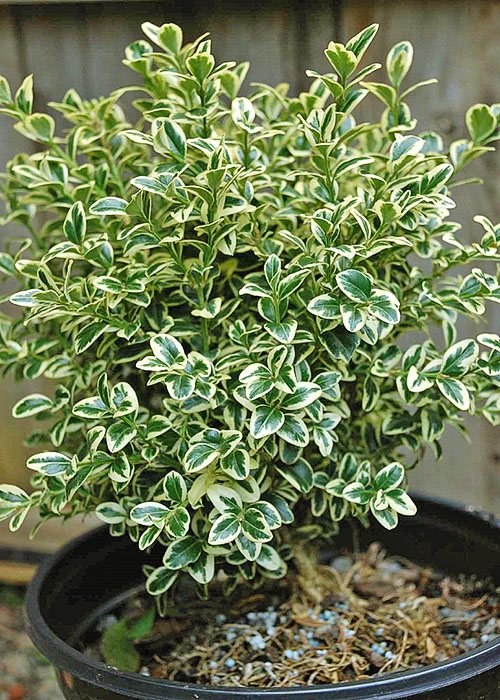

Distinctive features of all plant varieties are a low growth rate, glossy foliage, densely strewn with a dense crown, as well as easy care for boxwood at home. With the right approach, the plant becomes a real decoration of the home and garden, delighting the owner for many years with an unusual appearance and bright greenery.
For boxwood to really feel comfortable, it needs conditions close to natural.
The plant perfectly spends the summer period on an open terrace, in a garden or on a balcony. In this case, the boxwood needs to select places with good lighting, but we must not forget about protection from direct rays that burn young shoots and foliage.
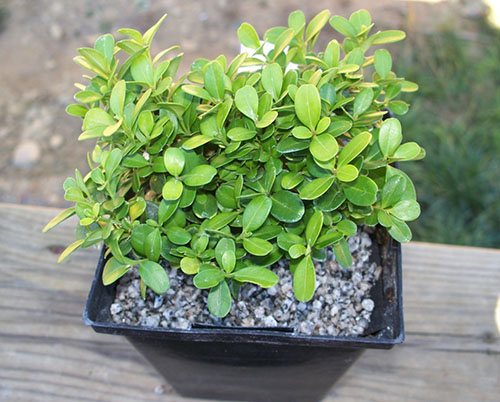

The ideal conditions for wintering indoor boxwood is a dry, closed room with a temperature of +6 to +16 ° С. If the plant is grown in a garden, it can suffer already at -10 ° C, therefore, garden bush and standard boxwoods must be provided with a reliable shelter until the frost passes. Caring for boxwood at home involves frequent and abundant watering. Boxwoods love moisture.Its hardness is not a critical indicator, however, plants do not tolerate watering with cold or chlorine-containing water poorly. In order not to harm the pet, it is better to defend moisture in advance.
In the warm season, boxwood requires abundant watering, because without water, it quickly begins to shed foliage and dry out. On hot days, boxwood responds well to spraying the crown.


By autumn, the frequency of watering is reduced, and in winter, only occasionally, as necessary, they moisten the soil, making sure that the water does not stagnate and does not cause rotting of the root system. The lower the air temperature in the room where the boxwood is located, the less its need for watering, but the soil should not be allowed to dry out.
During the period of active growth, from spring to early autumn, the shrub is fed with a frequency of 10-14 days, alternating mineral and organic additives.
From complex ready-made fertilizer mixtures for boxwood, the same compositions are suitable as for azaleas.
Conditions for growing indoor boxwood
Despite its status as one of the most common plants, boxwood is far from easy to grow, even in horticultural culture. Failures often occur in the cultivation of this plant, since the boxwood's dislike of winds, sensitivity to spring burns, dependence on the stability of winter temperatures and snow level are not always taken into account. In indoor culture, the selection of conditions for boxwood is as important as for its garden counterparts.
Indoor boxwoods in our range of flower shops are still a rarity. For indoor cultivation, you can purchase both genuine indoor boxwood and potted boxwoods in shopping malls. This plant is affordable and widespread. If you wish, you can grow indoor boxwood from a rooted cuttings that are sold for the garden, or you can get a cutting yourself.
Lighting and placement in the interior
Unlike garden potted boxwoods, which can be displayed in both bright light and partial shade, indoor boxwood needs more stable lighting. In the room for the plant, light places are selected, protecting the leaves from the midday sun rays. In diffused lighting, indoor boxwoods achieve maximum decorativeness.
Indoor boxwoods do not like artificial supplementary lighting, thus it will not be possible for them to compensate for insufficient illumination. Plants should be displayed on window sills - east, west or partially south windows.
When choosing a place in a room for boxwoods, it is worth remembering why this landscape gardening shrub was introduced into indoor culture. Boxwood is an evergreen accent, a small living potted sculpture worth using as a single accent.
This plant is an analogue of a large decor, a green sculpture, which is displayed as a tone and style setting in the most prominent places. In groups, boxwoods are not lost, but indoor boxwoods better reveal their true beauty in splendid isolation.
Temperature control and ventilation
For indoor boxwoods, cool conditions are preferred. Indoors, this plant does not tolerate heat very well, but it reacts well to low temperatures. In summer, if the air temperature exceeds + 23 ° C, measures should be taken to regularly ventilate and increase the humidity. In spring and autumn, cold snaps are not terrible for box trees, but it is better to limit the minimum temperature in any season, except for winter, + 12 ° С.
Indoor boxwoods should overwinter in low temperatures. Unlike tub plants, they do not tolerate a drop in air temperature below + 5 ° C. The wintering mode from +5 to + 10 ° С is considered ideal for this plant, but if such conditions are not possible, then it is necessary to lower the indicators in winter to at least + 12 ... + 16 ° С.
Boxwood loves fresh air.It is not only possible, but also desirable to be carried out in the summer to the garden, to the open veranda, to the balcony. In the fresh air, the plant is much less capricious than on the windowsill. But under the condition of regular airing, the boxwood will not suffer in the room.
Placing indoor boxwoods outdoors, you need to look for places in the shade for them: a sharp drop in the intensity of illumination on sunny areas is likely to be detrimental to the plant.
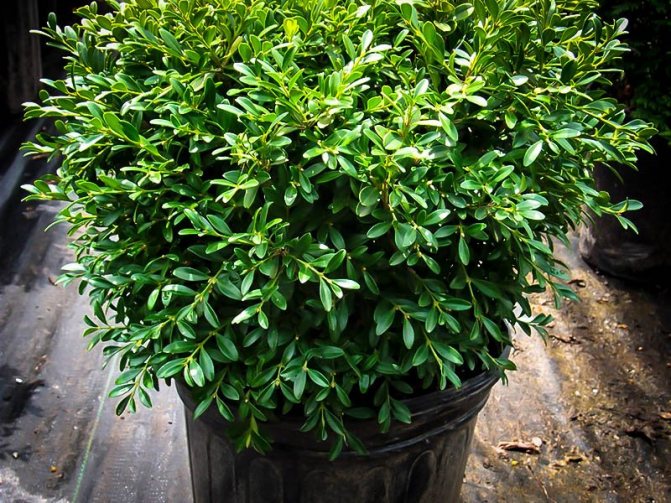

Small-leaved boxwood. <>
Reproduction of boxwood and care of seedlings
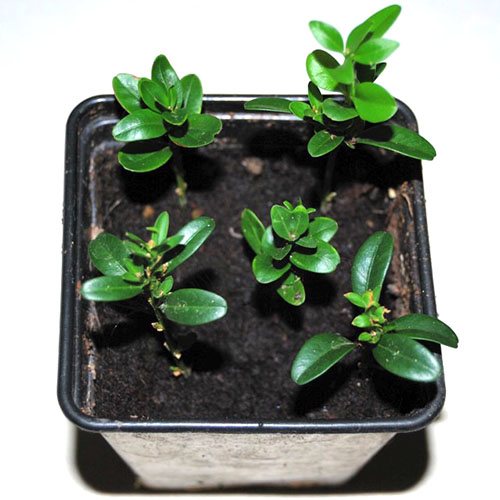

In natural habitats, boxwood reproduces both vegetatively and by seeds that are formed in capsule fruits and literally shoot out after ripening by how many meters.
To speed up the process and facilitate care, at home reproduction of boxwood is carried out using cuttings. You can get cuttings twice a year.
- In the summer months, young shoots that have recently lignified at the base are cut off for planting. In most cases, you can get these cuttings in June and July.
- In the last days of summer or at the beginning of September, you can also cut cuttings up to 10 cm long, containing 2-3 internodes.
The planting material is planted under a film in a moistened mixture of peat and garden soil.
At home, boxwood can also be propagated by layering obtained from young shoots inclined to the soil.
On such a branch, a cut of the bark with a fragment of wood is made and the shoot is pressed to the ground, securing this position with a wire bracket and directing the upper part of the layering vertically. Rooting boxwood can take up to three weeks. You can speed up the process with the help of growth stimulants, regular watering and a little heating of the soil. When young plants give roots, they are planted at a distance of 10 cm from each other or in separate small pots.
Growing conditions
Gardeners love buxus sempervirens for its shade tolerance. The corners of the garden, where other ornamental plants do not feel well, can be planted with boxwood bushes and give them any shape.
There are certain rules on how to propagate boxwood by cuttings in the summer at home, so that the plant is guaranteed to take root. It is believed that a bush that blooms in autumn must be transplanted in the spring, those that bloom in spring are transplanted in the fall.
In order for the bush to take root, it needs about a month for rooting, therefore, autumn plantings must be planned in such a way that a warm month remains after transplanting. While the plant gets used to the new place, it is artificially shaded, and it is better to immediately choose a dark place in the garden so that the sun's rays do not destroy it.
Planting an evergreen box tree and leaving is not difficult, but many novice gardeners make a typical mistake: they put the cutting in water, after which it dies. The fact is that the shoots must be rooted immediately in well-drained soil, there is not enough oxygen in the water, so the cuttings suffocate and do not take root.
Landing after purchase in a container
It is recommended to buy specimens grown in a nursery at the place of future planting, as they are most adapted to the conditions of the area.


Before planting, the earthen lump in the container is well watered - this is done a day before planting in open ground. You can get the plant, clean it from the ground and put it in water for a day. A root pit is made 3 times more than an earthen lump from a pot.
Transplanting a buksus plant step by step:
- Dig a hole of the right size and put it on the bottom 2 - 3 cm perlite, expanded clay or crushed stone for soil drainage.
- The earth, which was taken out of the pit, is also mixed with expanded clay in equal proportions. This will allow water to drain away from the roots in spring and autumn.
- The bush is placed in a hole and the roots are straightened.
- Gradually they cover it with soil, tamping it so that no air pockets remain. In order not to damage the roots, you need to do the powder slowly.
- Water the soil periodically before the next layer so that the earth lays down evenly, without voids.
- The last layer is also watered, but tamping is no longer necessary so as not to damage the roots in the soil.
For irrigation during planting, settled rainwater is used. For a small bush height 20 cm need to about 3 liters of liquid. Additional fertilizers are not needed during planting - the plant should get used to the soil on the site.
Video: How to plant and grow boxwood correctly
When the soil settles, you need to add more earth and lay it on top 2 - 3 cm perlite. Around the trunk at a distance of 30 cm make a limiting shaft so that the liquid does not spread. If there is no rain within a week after planting, the bush is watered at the root.
Important! If the weather is hot, then the plant is watered more, but not more often.
The soil
Reproduction of boxwood goes better if you first prepare the soil - add lime. Most varieties prefer neutral or slightly alkaline soil. Before liming, check the acidity with a pH meter. Slightly acidic soil is suitable for plants if the bushes grew on the same soil in the conditions of the nursery. This should be clarified when purchasing.
Boxwood does not like stagnant water, so planting it in lowlands means an eternal fight against fungal diseases and root rot.
Before planting, the earth is weeded and dug up, then holes are dug. To get a hedge per square meter, you need to plant from 15 to 30 plants in 2 to 3 rows. Minimal amount 5 - 8 per meter. Planting density depends on the shape of the bush - how much it can grow in width.
In order for the curb or hedge to be planted evenly, pull the rope, tying it to the pegs.


Lighting
You can choose any place for landing. It is good if it is shaded, since the leaves of the bush in the spring usually suffer from sunlight. The crown may turn yellow and crumble, exposing the branches.
Burns can be prevented partially with potassium-phosphorus dressings, strengthening the plant's immunity, but in open areas this does not save the day.
Boxwood feels good in the shade of trees, under a brick fence that blocks the sun, behind the house.
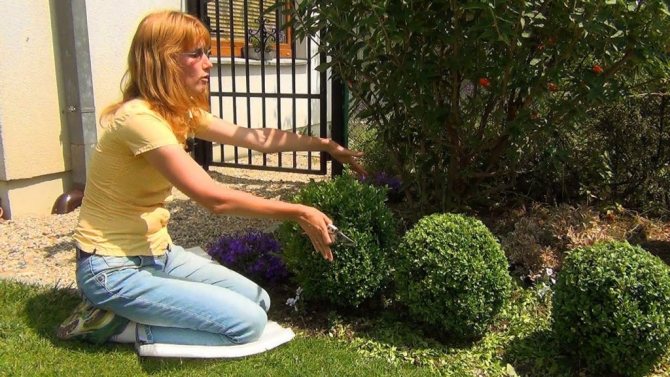

Watering
In city parks and squares, curbs are almost never watered - they have enough rainwater, which they store in leaves and shoots. Therefore, at home, you should also not abuse watering. If the weather is dry for more than a month, which is rare, then deep watering can be organized so that the soil is completely saturated with moisture. This amount will be enough for plants for another month.
Young, freshly planted plants need to be watered more often, since their root system has not yet taken root and may die.
When watering, it is important not to wet the leaves - in the lush crown, suitable conditions are created for the reproduction of fungal spores. Young bushes with weak immunity are especially susceptible to the disease.
In the fall, before wintering, deep watering is carried out so that the roots will stock up on water and survive the winter well. To do this, for every meter of planting, they pour about 150 liters of liquid.
If the plants are grown in large tubs, the soil must be kept moist. It is impossible to fill the pots, as this causes rotting of the roots and fungal diseases.
Care before wintering
Some types of boxwood or young plants planted this summer are covered with agrofibre, and the soil near the roots is mulched with a layer of peat. It is important that the peat does not come into contact with the shoot. The fabric protects the leaves from the wind. In cold regions, non-resistant varieties are hidden in houses from boards, covering them with a thick cloth, like the way roses are covered.


Pruning methods
Without pruning, boxwood bushes look untidy, so you need to prune them 2 - 3 times per season - in spring, summer and autumn. The number of activities also depends on the fertility of the soil.
On poorly fertilized soil, shoots grow slowly, and leaves form close to each other. The effect after trimming lasts longer. On the contrary, with an excess of fertilizer, the plants stretch out and the shoots are visible through the foliage. This is considered a gardener's mistake, since the decorative quality of the boxwood is lost - the splendor and density of the crown.
Pruning happens:
- Single. Held at the end of June when the growth rate decreases. The next shoots will be weaker and will not greatly change the shape of the plant, will have time to woody before winter and will not suffer from frost.
- Double. The first pruning is carried out before the start of sap flow, giving the shrub the desired shape. The second event is at the end of June, so that the new stems have time to become covered with a woody layer.
- Triple. The first is in March or April, the second is at the end of June, and the third is in August. Triple trimming is done to keep the figure alive in the desired shape.
It is recommended to do a single or double pruning of boxwood, if the shape of the bush is usual - spherical or rectangular.
How to transplant boxwood?
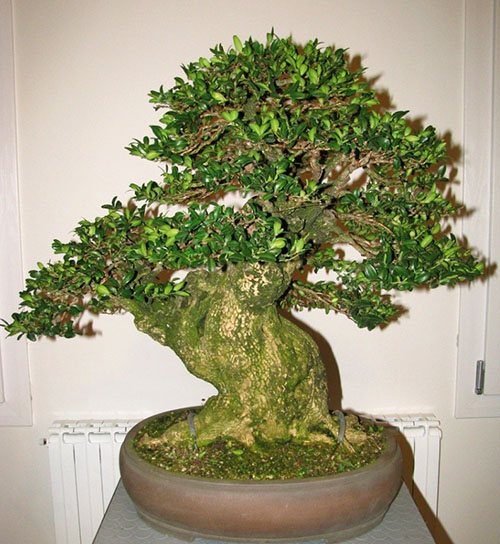

To transplant young seedlings and already mature boxwood bushes, a soil mixture with a neutral reaction is needed, consisting of:
- two parts of humus;
- the same amount of sand;
- one part of sod land;
- a small amount of fine charcoal.
If the soil is too loose, add a little clay to it. This is especially important when planting a boxwood intended for bonsai and which subsequently does not transplant for a long time.
All types of boxwood require good drainage of fine gravel or stone chips with coarse sand.
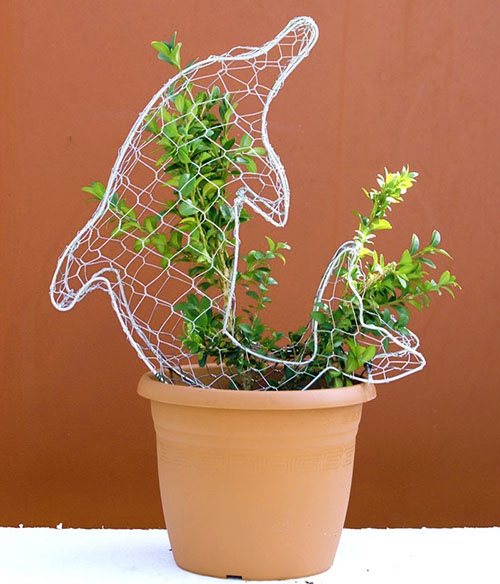

The best time to transplant is spring. During the warm months, the plant will have time to acclimatize, and winter will be less of a challenge for it. The new pot should not be overly large, especially when it comes to replanting an adult bush.


How to transplant store-bought boxwood with a closed root system? Often in such plants, the roots grow through the drainage holes, and inside the container they are woven into a tight ball. In this case, such a lump cannot be attempted to straighten or untangle. The roots that have got out on the walls of the pot are carefully cut flush with the bottom, the lump together with the peat soil is removed from the container and gently transferred into the prepared container and the prepared mixture is poured.
Boxwood pests
The culture is damaged by such pests as spider mites, scale insects, butterfly caterpillars. Special industrial preparations are used against parasites.
One of the worst pests is the boxwood moth. It causes yellowing and leaf fall. In a short time, the firebrand is capable of inflicting significant damage to greens.
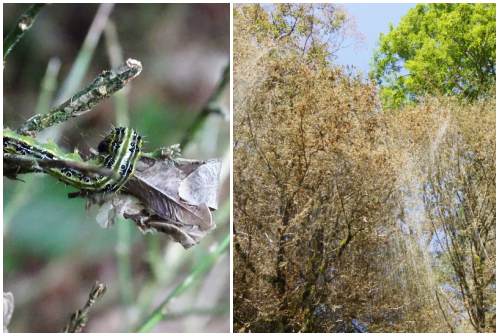

- Carefully cut out all damaged branches and burn them.
- It is good to treat the foliage with anti-fire preparations (Decis, Karate). The processing process is complicated by the very dense crown of the plant.
- The above manipulations are repeated 2 - 3 more times, with an interval of 10 days.
The following video will tell you about how to deal with a dangerous pest.
Boxwood pests and diseases


Most cases of loss of visual appeal by a shrub, as well as damage to a plant by pests and diseases, are associated with a violation of the rules for caring for boxwood at home:
- Excessive watering during the cold season leads to root rot and other boxwood diseases.
- Drying out of the soil and dry air in the room is the reason for the loss of foliage and drying out of the young parts of the shoots.
- If the air temperature remains above 18 ° C for a long time, then the boxwood also begins to lose leaves and weaken.
Neglect of fertilizing, frost damage and other factors also lead to the weakening of the plant. Boxwood diseases and pests affect precisely weak, emaciated specimens.
Among the pests that can quickly settle on a weakened plant are spider mites, boxwood gall midges and various types of scale insects.The leaves of the bush are affected by the larvae of miner flies, which lay their eggs in plant tissue.
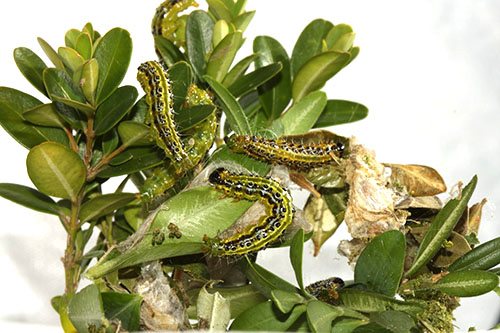

And more recently, boxwoods in our country and throughout Europe have a new enemy brought from East Asia. The boxwood moth, along with seedlings, was first brought to Germany in 2006, then it was found in Holland, Switzerland and other parts of the Old World. And in 2012, caterpillars and butterflies came to Russia on the boxwood intended for landscaping the Olympic Sochi. Today, the pest causes serious damage to the wild plantings of the relic Colchis boxwood.
Modern insecticides and fungicides are used to control larvae, ticks and caterpillars on box trees. Sick and pest-affected shoots are cut and destroyed. At the same time, they must establish caring for the boxwood at home, providing the plant with proper watering, temperature regime and feeding.
Pruning rules
In the summer, boxwood is pruned solely for decorative purposes. In the fall, the plant needs this procedure, as it stimulates the growth of new shoots in the spring.
Pruning in the fall is performed at the end of October to freezing temperatures by completely cutting off damaged, old and dry branches. And all the rest are shortened by about 2 cm.
Important! The pruning procedure is performed only on those shrubs that are more than two years old. Young specimens are left intact, because in the spring they may not recover.
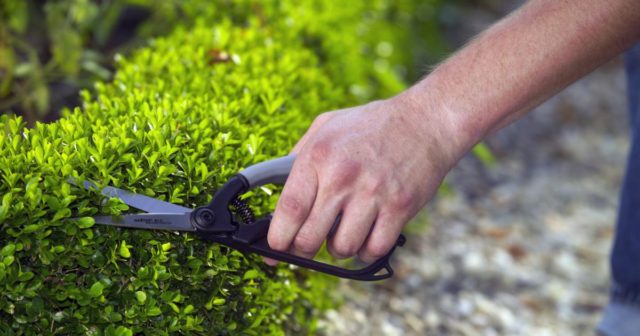

Pruning boxwood in autumn will allow it to grow a new, dense green mass in the spring.
Crown formation and boxwood pruning
Since the boxwood does not differ in its growth rate, it is easy to cut it, giving the crown a variety of shapes.
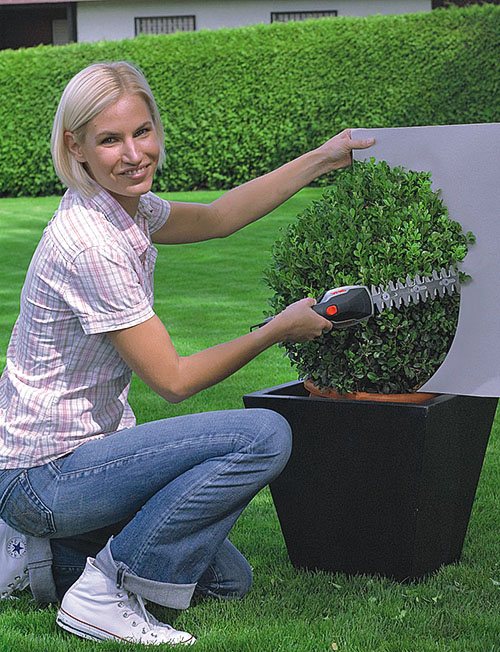

Since the pruning of boxwood affects the shoots of the shrub, removing their tops leads to the beginning of active branching, the crown becomes even denser, and there is no gradual exposure of old branches, as in wild species. Thanks to competent pruning, boxwoods are grown at home as bonsai, formed in the form of standard trees, silhouettes of various animals, geometric shapes and other objects.
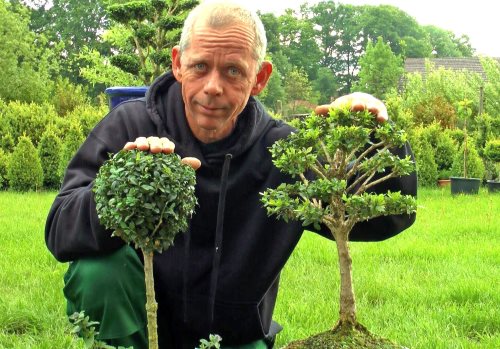

Pruning boxwood will be most effective if done from April to July, when the plant's growth rate of shoots and foliage is at its maximum. To form the crown, special templates are used today to help quickly and accurately create a conceived composition.
Video about boxwood evergreen globular
Why you need to cover boxwood for the winter
As we mentioned earlier, boxwood tolerates the cold quite well. And more often than not, he is not covered at all. In regions where the temperature is stable in winter, this option is quite possible. In the case of an evergreen shrub, he needs shelter in order to protect him from the sun. The whole problem is that during long winter thaws, plants in open areas and well-lit by the sun can start growing.
Untimely awakening provokes drying of leaves and shoots. Gradually, the process becomes inevitable. Sharp temperature changes harm the shrub much more than frost. Young shoots and weak, completely unrooted bushes suffer from the bright scorching rays of the February and March sun. Also, the shelter protects the boxwood from the drying wind, which dries the earth faster than the sun and frost.
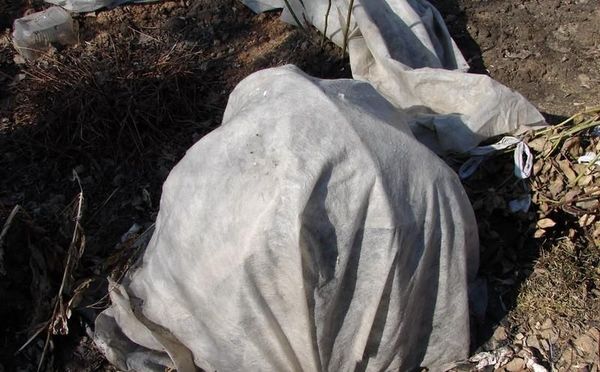

Boxwood in a flowerpot
The evergreen boxwood plant is becoming more and more popular in our latitudes.
In Latin, its name sounds "Buxus" - most likely, it came from the Greek word "buxe", which means "dense". According to scientific classification, boxwood belongs to the genus of evergreen trees and shrubs that grow very slowly. Currently, this genus has about a hundred species. In the wild, they grow in the West Indies, East Asia and Mediterranean countries.There are three largest areas where boxwood grows - African, Central American and Euro-Asian. Boxwood is rightfully considered one of the oldest plants. It has been used as decorative planting in our country for more than 300 years. Now the conditions for its cultivation have already been selected not only in the garden, but also in a flowerpot on the windowsill. This shrub is often called a sculptural plant - its plantings grow extremely slowly and can be given any desired shape. Boxwood hedges and borders are the most popular decoration for parks and lawns of cities in any region (not only the southern one).


For a long time, boxwood has been considered a sign of wealth and success around the world. These plants belong to long-livers: with their very slow growth, they live up to 500 years. Boxwood wood is very hard; handles for various tools, coils, combs for hair, buttons and other small items for which strength is important are made from it. In the Middle Ages, according to the writers of that time, boxwood from Abkhazia was very expensive and was sold in Europe in scanty quantities.
Features of the growth of box trees in the southern and northern regions
Boxwood, or buxus, is prized for its beautiful glossy green foliage. It is actively used for landscaping provincial towns in southern Russia. In temperate regions, it grows up to 2 m, remaining in its bright green decoration all year round.
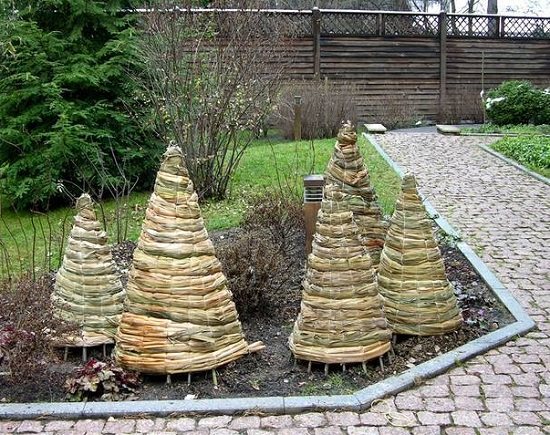

The use of willow wattle
There are more than 100 species in the genus, but not all of them take root in the northern regions. For cold climates, only frost-resistant varieties are selected. So, evergreen and small-leaved boxwood is successfully grown even in Siberia, and Balearic and Colchis are practically not found there. If in warm regions the bushes have enough watering and periodic feeding, then in the northern corners of the country they need to be prepared for wintering.
If you decide to choose this guest for landscaping your personal plot, then you should take care of the selection of companions for him. The coniferous group is the perfect combination. Nana fir, pillar-shaped juniper and even boxwood ball will look harmonious when planted together. The effect is achieved by combining contrasting shapes. More capricious in the composition will be spiraea, weigela, virgin mock-orange, which is mistakenly called jasmine.
Do I need to cover the boxwood for the winter?
When deciding whether to cover the growing seedlings, take into account the characteristics of the region. In the southern regions and the middle lane, there is enough snow cover for varieties of evergreen boxwood up to 1 m in height. If the seedling is of the first year of planting, then it is imperative to organize protection.
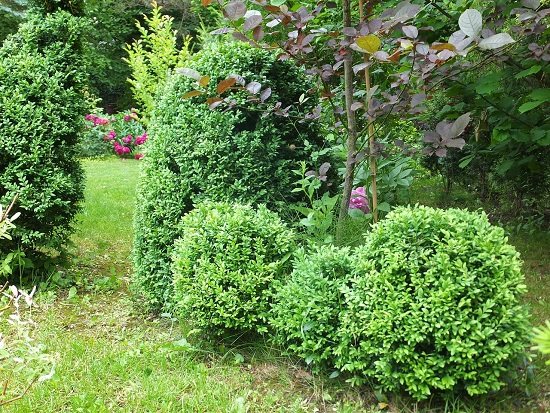

Boxwood plantings
Frost significantly affects the condition of the bush, but this is not the only reason for protection. In winter, the buxus enters the resting phase, its growth stops. If during this period a lot of sunlight falls on the foliage, then the processes of photosynthesis will resume in it. It is impossible to feed the plant through the frozen winter soil, so the awakened upper part will begin to dry out. Young leaves that appeared out of time will immediately suffer from the cold. Considering the above factors, it can be argued that a shelter for the growing boxwood is necessary.
Autumn preparation time depends on the weather conditions of the region.
It is necessary to finally erect the protection from the moment when the temperature of -10 ° C is established on the street. If you cover the bush earlier, then possible warming will lead to the fact that it begins to rot under a protective layer, it will not be possible to preserve it.
About haircut, watering and autumn feeding
You need to prepare for the wintering of boxwood with all responsibility. In order for the plant to survive the resting phase, it is saturated with water and fertilizers. This is important due to the evaporation of moisture under the influence of frost.As a fertilizer, any complex for evergreens or special formulations for box trees are suitable.
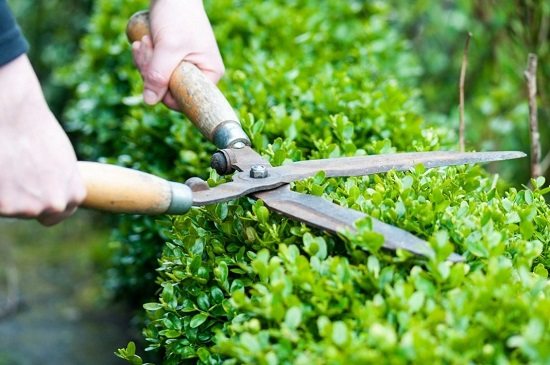

Haircut for young growth
In autumn, the plant needs potash and phosphorus fertilization. After 2-3 days after abundant watering, the trunk circle is mulched. The layer is made at least 5-8 cm so that the root system is reliably protected. Rotted needles or peat are used as mulch. Dry foliage is not suitable, as it can overheat over the winter and lead to fungal diseases. The soil is mulched at a short distance from the trunk (2-3 cm) so that air flows freely to the roots.
Autumn pruning of tugs is the final stage of bush formation. It is produced in late October or early November, before the onset of severe frosts. The procedure is carried out in order to start the growth of young shoots in the spring. Remove the last young shoots up to 2 cm long. If you need to form a branching, then you can remove the basal shoots up to the third young bud.
Varieties
Nowadays, boxwood is widely used in the art of landscape design. Let us consider in more detail the types of this plant that are used in this area more often than others.
Boxwood evergreen in nature grows in the Caucasus Mountains and the Mediterranean countries. Unpretentious to lighting, he is equally good both in partial shade and in sunny areas. Without timely pruning, it can be quite high - up to 3 meters high.
Small-leaved boxwood is a dwarf shrub. Compared to the previous relative, it tolerates winter cold better. This species comes from South Asian specimens, and can survive a 30-degree frost without shelter. Differs in compact form and decorative crown. It is quite suitable for growing in a flowerpot.
Bolear boxwood is the largest representative of the family, the leaves are long - up to 5 cm. It came to us from the Bolean Islands (Spain). In the wild, it is found in the mountainous areas of southern Spain, Portugal and on the shores of the Crimea.


Care Tips
As already mentioned, boxwood does not belong to whimsical plants. It is grown without much difficulty in the open field, but with the same success it can be obtained from boxwood at home, in a flower pot.
This plant does not need a special light regime; a flowerpot with a buxus can be placed both on a sunlit windowsill and on a completely shaded one. For the successful development and growth of boxwood at home, room temperature is quite suitable. In winter, when its biorhythms slow down naturally, it is recommended to lower the temperature of the content to 15 degrees.
In the summer, the buxus requires abundant watering. Water it as soon as the soil dries up. In the cold season, when the air temperature drops, watering is reduced to moderate. It is important to prevent excess water near the root system - waterlogging can provoke root rot.
The humidity for keeping indoor boxwood should be moderate. If the plant is looked after correctly, then its leaves must be sprayed from time to time. This procedure will prevent the leaves from drying out and curling, and will also protect the plant from pests.


Boxwood is rarely transplanted - it is very slow in growth. One transplant is enough for several years. The transplant is usually done at the beginning of spring - at this time the processes of plant growth and development are activated. The next flowerpot for this box must be larger than the previous one.
Boxwood usually does not get sick during transplantation, but it is important to make sure that there is drainage at the bottom of the pot that performs its functions well (this is perhaps the basic rule of caring for boxwood at home) Excess moisture near the roots is very often the cause of plant diseases.
The soil for the skid must be structured and nutritious. Specialized stores offer a ready-made soil substrate, but you can prepare it yourself.To do this, you need to take 4 parts of sod land, 2 parts of leaf and 1 part of sand with large particles. It is better to transplant a plant bought in a store immediately - it is usually sold in the so-called transport soil, which is not as nutritious and dries up quickly. They are transplanted very carefully - it is important not to injure the roots. The day before transplanting, the seedling of the buxus is watered abundantly - this will make the soil ball softer.
Boxwood can be propagated in two ways - by cuttings or from seeds.
When propagated by cuttings, twigs are cut from adult and healthy plants. This is usually done in April or May. At the same time, shoots are taken that have grown during the past year (a small part of the year before last is acceptable). The length of the cutting should be 15-20 cm. The cut branches are embedded in the soil with the addition of a rooting stimulator and covered for a while with a transparent vessel, building something like a small greenhouse. When the boxwood reproduces in this way, the appearance of roots should be expected in a month, the complete rooting of the plant occurs only by autumn.
Seed propagation of this plant is more painstaking. First of all, its difficulty lies in the fact that buxus seeds quickly lose their germination. Therefore, it is better to sow the change immediately after harvesting or store it in a glass container in the refrigerator until spring. It is better to stratify the seeds purchased in the store - they are kept in wet sand at a temperature of +5 degrees for two months. After this procedure, which significantly increases the germination of seeds, they are sown in a flowerpot and covered with a film for the first time. For germination of seeds, the temperature is maintained at +15 degrees. Germination time is quite long - from 1 to 3 months.
Experience shows that even a beginner can grow boxwood at home. You just need to be patient - and you will receive an original decoration of your home.
Growing boxwood from seeds
There are 2 ways to propagate boxwood: by cuttings and seed. The first method is the simplest. It is enough to cut off green cuttings 7-9 cm long in the middle or late summer and root them. The seed method is more laborious, since the buxus seeds quickly lose their germination.
Knowing how to grow new specimens from seeds, you don't have to worry about a gift for familiar gardeners. The instruction is simple:
- The purchased seeds must be soaked in a growth stimulator for a day.
- The planting material processed in this way is transferred to the fabric in a straight line, covered with the other end and rolled into a roll.
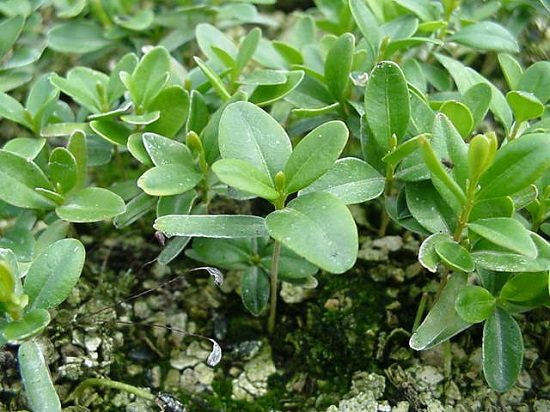

Grown seedlings - The resulting package is kept wet for a month, until white roots appear.
- For planting, a mixture of peat and sand is prepared in equal proportions. Sprouted seeds are planted in the substrate. The container is covered with foil and stored at + 15 ° C.
- Seedlings are expected for 3 weeks, after germination, the film is removed.
- With the onset of spring, the seedlings are moved to normal soil.
Store-bought buxus seeds are recommended to be stratified. They are placed in wet sand and kept in the refrigerator for 2 months. After such treatment, germination increases significantly.
Planting and caring for boxwood indoors is a small challenge for the grower, but the graceful compact bonsai is well worth the effort. You just need to water and fertilize the plant, monitor the lighting and temperature. The bush bush reacts gratefully to pruning, forms beautifully and clears the atmosphere in the room.
Plant characteristics and features
Recently, more and more people have begun to grow it as a home, indoor plant. The reason is the beneficial properties that boxwood has. The plant releases phytoncides into the air. These volatile substances are able to neutralize harmful bacteria that accumulate in the air.It also has a pleasant smell, which is released during flowering or when pressed on the leaves.
It should be noted that only three types of plants are suitable for indoor cultivation:
- small-leaved. The maximum length of the leaves of such a box tree reaches 2.5 cm;
- bolear. This plant has larger leaves, up to 4.5 cm;
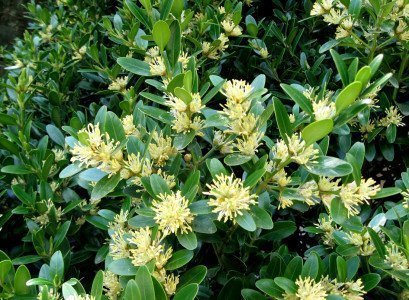

- evergreen. This kind of boxwood is the most common. The length of its leaves reaches three centimeters.


You should pay attention to the fact that evergreen boxwood at home is quite whimsical. With the wrong care, he can easily shed the leaves.
Cleaning, loosening and mulching the trunk circle
Before watering in the fall, be sure to remove fallen leaves, debris and weeds around the boxwood trunk. And then the top layer of the soil is loosened so that oxygen can pass to the roots without difficulty. Further, mulching is carried out. It is on the correctness of this procedure in the fall that the resistance of the roots of the bush to freezing of the soil depends.
Mulching is done 2-3 days after watering. For this purpose, needles, peat or pine bark are used. Lay a layer of mulch of at least 5 cm, but leave approximately 2 cm of free space around the entire circumference of the trunk circle.
Important! In no case should fallen leaves be used as mulch, as it tends to rot, which can cause rot.
Boxwood - features of cultivation
So how to care for evergreen boxwood at home? This is not an ordinary indoor flowerpot, which is enough to water and forget several times a month. It requires careful and careful maintenance.
Growing boxwood in an apartment is not that difficult. The ideal place for this plant is a windowsill, which has direct sunlight access. It can also grow in low light, but then the boxwood will look more like an ornamental plant.
It is important to know that you do not need to replant it often. Enough once for three years. When replanting, the soil should not be homogeneous, but consist of the following parts:
- 4 parts of sod land;
- 2 pieces of leafy land;
- 1 part coarse sand.
Shrub shelter methods


Boxwood easily tolerates winter. But on condition that it is snowy.
The snow serves as a natural shelter and helps the bushes to defend themselves naturally.
An important condition for the safe survival of boxwood in winter is also the correct landing site.
For this purpose, boxwood is planted in the shade, under large plants, or next to buildings in the northeast and northwest of them.
The essence of this is that in open areas boxwood during the thaw, warmed by the sun, may start to grow at unfavorable times... Foliage that wakes up at the wrong time will certainly suffer at the first frost. Therefore, it is necessary to cover the boxwood for the winter.
Shelter boxwood for the winter consists of the following:
- Garter bushes.
It is necessary for standard plants. First, you need to build a support for the bush, especially if the bush is tall enough. If this is not done, then it can break under the weight of the snow. The base of the bush is tied to the support with a rope.
Plants in the hedge are neatly tied with rope in groups.
Shelter.
To protect them from frost, a layer of covering material is thrown onto the bushes, and if severe frosts are predicted, several layers are necessary.
Covering material can be directly wrapped around bushes. But if possible, it is more expedient to build frames. You can make them from wire, placed crosswise over the bush. Cover this frame with material and fix it at the bottom with a heavy load or sprinkle it with earth.
The frame must be made of durable materialsso as not to bend under the weight of the snow and not to crush the bush.For tall specimens, it is possible to use U-shaped fittings installed crosswise over the bush.
Before the onset of persistent frost one edge of the material must be liftedso that air can flow to the bushes.
It is possible to finally fix all the material only when the temperature is set at minus 10 degrees... If you do this earlier, then during thaws, the bushes can support.
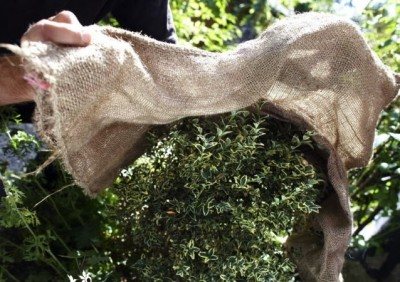

For boxwood used as hedges, it is more convenient to build shelters from spruce branches. The branches are tied in several pieces and they are surrounded by curbs in the form of a hut.
When enough snow falls out, throw it onto the shelter of spruce branches. This will create an air cushion and keep warm and moisture inside the bushes.
If boxwood bushes grow on your site next to roses, you can make a common frame shelter for them.
For air access under the shelter in several layers, tuck under the material piece of flexible pipe... Fold the protruding end up and fix it at a low height.
Air will flow through such a ventilation hole, and frost will not penetrate.
You can visually familiarize yourself with the preparation of boxwood for winter in this video:
Plant care
In order for boxwood to please you with its rapid growth, you need to remember about the recommendations of specialists.
- Lighting. Boxwood loves bright, diffused light. Although in summer it is better to hide it from the direct midday sun. If the plant is in a garden, then place it in the shade of taller trees or shrubs.
- Temperature. In winter, it is optimal around 5 ° C, and in spring the temperature should not drop below 12 ° C. In summer, normal room temperature will suffice. But do not forget that boxwood loves the open air, so it is advisable to take it out to the balcony or yard in the summer.
- Watering... In winter, this should not be overused. You need to look after the plant and water it as needed. But in the summer you need to water boxwood abundantly and often. It is very important that the roots of the plant do not dry out, otherwise it will be impossible to propagate it later.
- Air humidity... Boxwood is a moisture-loving plant. You can not be afraid to spray it from time to time with settled water.
- Fertilizer. To keep the boxwood healthy and evergreen, you can feed it with the same fertilizer used for the azalea. This is best done from March to August, every two weeks.
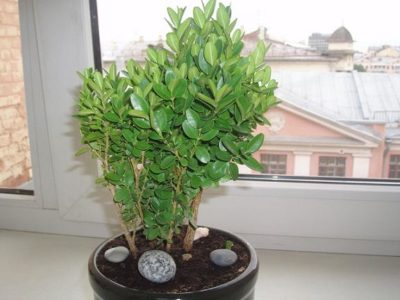

These rules will be enough for the plant to please its owners for many years.
Winter care for tub box
If your boxwood is in a pot, then naturally the frost will damage, first of all, the roots, so they need to be well protected. You can put the pot in a larger pot. This method of protection is the most stylish and aesthetic. Between the walls of the two pots you will have a small space that needs to be filled with "insulation". Crushed bark or small sawdust will work ideally as a "heater". Place your flower on a wooden stand or lining to keep it out of contact with the cold, frozen ground. But why before that did we advise you to plant boxwood in a shady place? Let's dot the i's. The fact is that the most vulnerable boxwood is precisely the spring time, when the first sun appears and the boxwood, at the call of nature, wakes up from hibernation. But due to the fact that the weather in our area does not differ in stability in the spring, boxwood leaves begin to crack from lack of moisture. That is why leading decorators-gardeners recommend planting boxwood in the shade so that it “wakes up” as late as possible, wakes up when summer is just around the corner.
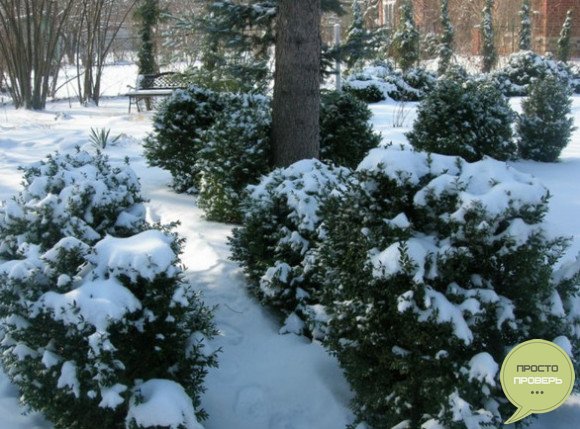

Reproduction of boxwood
With proper care, it is quite easy to propagate evergreen boxwood at home. You should pay attention to the fact that this plant reproduces with the help of cuttings and seeds.
Cuttings are best cut at the end of summer. It should have two or three internodes and be no longer than seven centimeters. Then the plant will take root, and will grow and bloom for a long time.
Put the prepared cuttings in water until the roots appear, or lower them immediately into a pot with soil.


Now everyone knows how to care for boxwood and can independently create a unique atmosphere of the Garden of Eden in their apartment, which remains evergreen for many years.
Boxwood plant - description, photo
Other names for an evergreen shrub are stone tree, busk, beech. This pliable plant with hard wood and almost round leathery whole-edged leaves is a melliferous plant. But you cannot eat the honey obtained from it, since all parts of the bush are poisonous.
In nature, the buscus grows to a height of two to fourteen meters. It grows in Japan, Oceania, Asia Minor, southern Europe, central America and the southern part of the African continent.
The shrub does not grow very quickly. For a year, the crown of box trees grows only five to six centimeters, therefore trimmed shrub retains the density and shape of the crown for a long time... For this, gardeners love him and are widely used in landscape design.
Those who are fond of exotic will be interested in the article about growing feijoa at home.
Home cultivars
The genus of boxwood has 104 species. Plants have been cultivated for about 300 years both outdoors and indoors. It is appreciated for its rounded leathery green foliage, densely covering the shoots. The branches grow slowly, an average of 5-6 cm per year. This makes it possible to form geometric shapes and more complex structures, for example, animals, from the growth.


Although tugs are more likely to grow on plots, some varieties can be grown indoors. Boxwood is a poisonous plant, so the flowerpot with it must be isolated from children and pets. At the same time, boxwoods emit phytoncides into the air, which disinfect the room.
Boxwood at home takes root well if you provide it with the proper conditions. Of all the species diversity, varieties of evergreen boxwood, small-leaved and bolear are successfully grown on the windowsill. The Garland species is well suited for creating bonsai.
The best varieties for growing in a pot:
- Elegans is a spherical specimen with bordered oblong leaves;
- Curly Locks attracts attention with bizarrely twisted shoots, his photos leave no one indifferent;
- Marginata with leaves of a pale green color and a yellow border around the edge is ideal for decorating window sills and terraces;


In flower shops you can buy a pot of young boxwood bush. In healthy specimens, leaves of a rich green color, stems are not bare. In a pair with him, novice growers usually buy myrtle, which is not so difficult to cope with at home. Indoor hydrangea and lemon tree will be more capricious.
Boxwood varieties for the Urals and Siberia
For growing boxwood in Siberia and the Urals, only winter-hardy varieties are suitable, which tolerate frosts down to -30 degrees and below. Often, even their individual shoots freeze slightly, but in general, the bush copes with such conditions and recovers well in the warm season. Gardeners living in regions with frosty winters are advised to pay attention to the following varieties:
- Blauer Heinz is a dwarf shrub that grows up to 20-30 cm in height. Due to its miniature green-blue leaves, it is often used to create patterns and designs in flower beds.
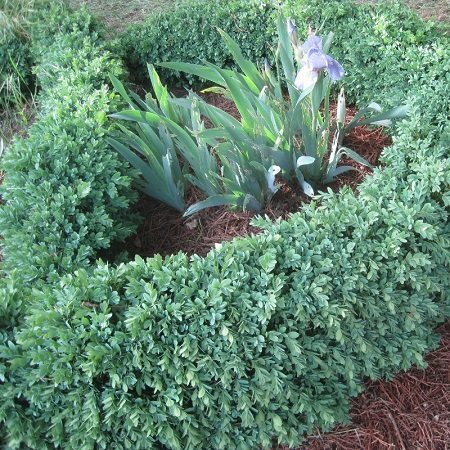

- Elegance is an evergreen boxwood that is well suited for the climatic conditions of Siberia and the Urals. The shrub grows up to 1 m, up to 75 cm in diameter. Looks good in front of the entrance to the flower garden, and is also used to frame paths.


- Faulkner is another type of boxwood for Siberia.It grows to a small height of just over 1 m. The crown is decorative, compact, and eventually takes on a spherical shape. There is evidence that this boxwood can withstand extreme frosts down to -45 degrees.
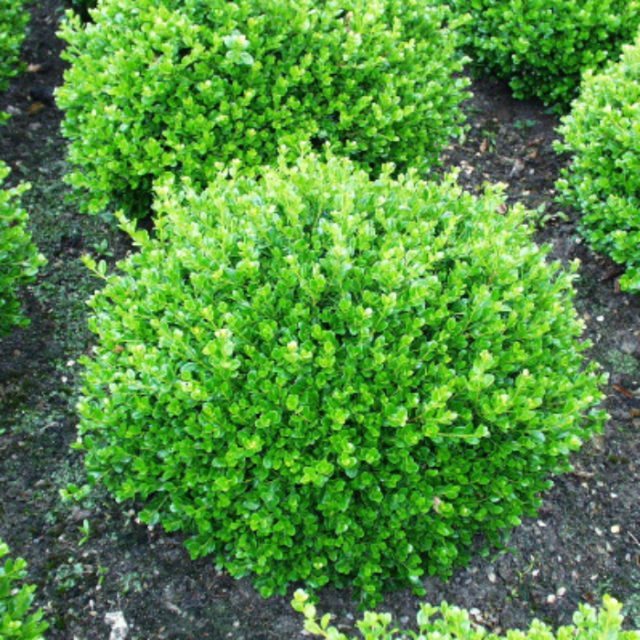

- Winter Jam is another interesting frost-resistant boxwood that reaches a height of up to 1.5 m. Moreover, its crown needs regular pruning in order to get the desired shape. Well suited for creating a green hedge in an open area with maximum sunlight. For the winter, the bushes must be protected from snow with a covered frame.
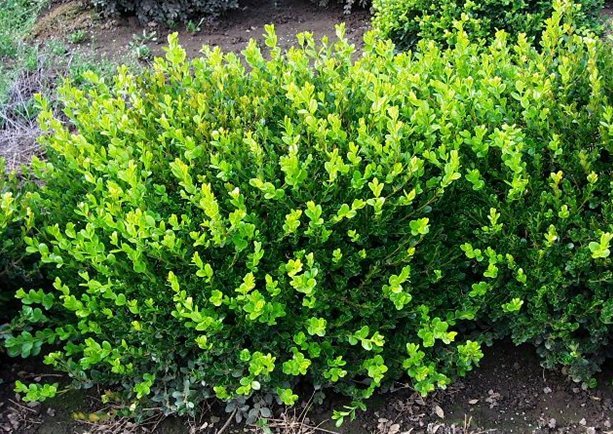

- Balearic is a winter-hardy boxwood for Siberia, the Urals and other regions. Resistant not only to frosty winters, but also to strong winds. Another advantage is that the rich green color does not fade in the bright sun, so you can safely plant it in an open area.
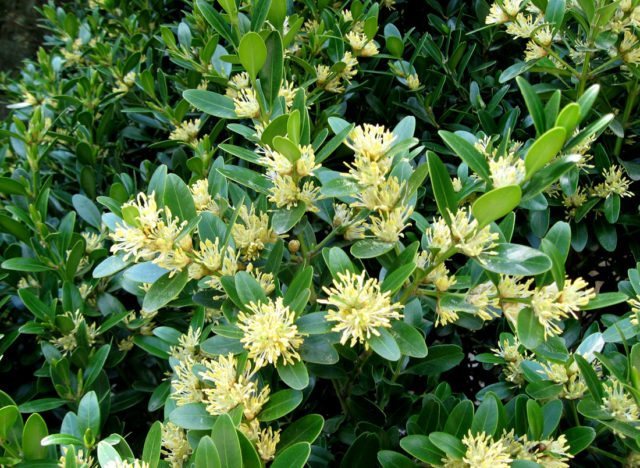

Caring for a boxwood bush at home
Onboarding a rookie begins with proper placement. Evergreen pots are set up in areas with little shade, as in the case of outdoor cultivation. Foliage can be affected by excess sunlight. The best location would be a west or east window. Lack of light can also negatively affect growth, so you should not send it deeper into the room.
From time to time, you can take out the pot with the buxus to an open space. In the fall, the plant enters a state of dormancy, it should be transferred to a warmed glazed loggia. Another wintering option is on the floor by the balcony door. The permissible temperature in summer is room temperature, in winter - from +10 to + 15 ° C. From dry air and high temperatures, the tree can shed its leaves.
- Watering, top dressing in summer and winter
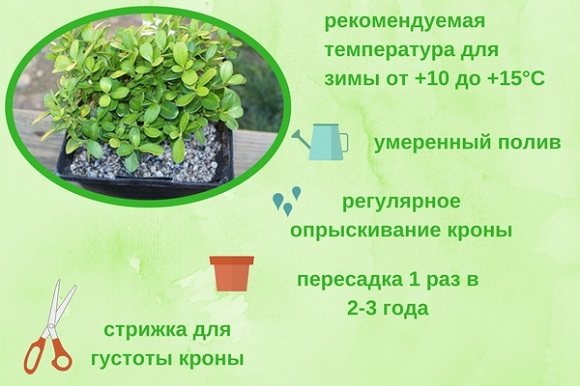

Indoor boxwoods are sensitive to humidity. They need to be not only watered regularly, but also sprayed. If there is not enough moisture, then the edges of the leaf blades will begin to dry out. During the growing season, to stimulate the growth of shoots, it is useful to add bioregulators (Epin) to the water prepared for spraying. If the air in the room is dry, boxwood leaves will immediately begin to curl, pests (scale insects, spider mites) will appear on the crown.
It is necessary to constantly monitor the condition of the soil and prevent it from drying out.
As soon as the topsoil dries up, add an additional portion of moisture. In winter, watering is reduced to moderate. Spraying is done less often, they do this to prevent foliage from curling.
Home care for buksus consists in timely feeding with nutritional complexes. Fertilizers are taken for evergreens; complexes for ficuses or azaleas are suitable. The frequency of feeding is 1 time in 2 weeks. For example, hibiscus at home is more voracious, it is fed every week since March. Be sure to carry out a feeding procedure before cutting, since fertilizers stimulate the growth of green mass.
Video about getting new specimens from cuttings.
Changing the container is a rare event, as the plant develops extremely slowly. It is enough to change the container every few years. The transplant is done in early spring, the pot is selected a little more than the previous one.
The soil for plants should not be acidic.
The approximate composition of the substrate: 1 part of coarse sand + 2 parts of leaf land + 1 part of coniferous land. You can add a little bone meal to the composition. A drainage layer at the bottom of the tank is required, since the root system does not tolerate stagnant water well. After the transplant, the rules of care remain the same. From above, the substrate is covered with sphagnum to retain moisture and aesthetics. The moss is changed every 3 months.
The main reason to grow a boxwood tree is the formation of various shapes from it. A haircut thickens the crown, makes it thicker. Pruning is carried out throughout the year as needed, but only from the second year of life. Before starting cultivation, you need to think over the final shape of the bush.Special metal templates may be needed. Usually they are used to give the shape of an animal to a shrub.
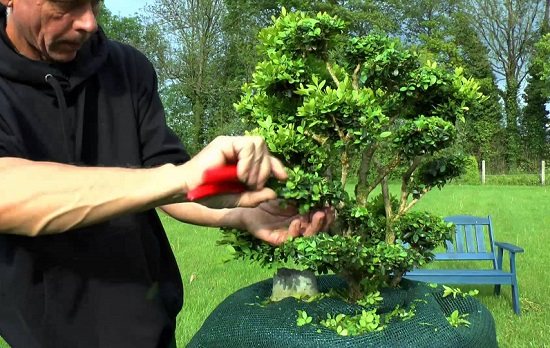

Bonsai also looks beautiful on the windowsill. To create it, shoots are cut from the bottom of the bush, and the top is formed in the form of a ball or drop. To create inclined delights, the shoots are fixed with wire, giving them a certain angle of inclination.
You need to take care of the plant carefully. Since its foliage contains toxic substances, all work is carried out in protective gloves. After contact with the plant, hands should be washed.
How to grow boxwood?
Caring for such a shrub is a matter not very troublesome... The most important thing is timely watering, feeding, cutting and shelter for the winter.
Watering
A week after planting, if there was no rain during this time, the plant is watered at the rate of one bucket per bush about one meter high. During dry periods, watering should be done no more often, but more abundantly. It is better to underfill buscus than waterlogged, because its roots begin to rot from excess moisture.
Watering should be done in the morning or evening, pouring water inside the trunk circle. After watering, weeds are removed and the soil is loosened. So that the roots of the plant do not dry out and weeds do not grow, the soil around the plant is covered with mulch. This should be done when the soil warms up well in the spring. In this case, you need to make sure that the mulch does not come into contact with the trunk and shoots.
Top dressing
When caring for boxwood the shrub must be fed... If a seedling was planted in open ground in the spring, then the first time fertilizers are applied a month after planting.
During the period of active growth, organic matter or mineral fertilizers are used. In autumn, when digging the soil, fertilizers with phosphorus and potassium are used. The plant does not need nitrogen in winter.
How to cover boxwood for the winter?
How is boxwood wintering and should there be additional preparation for winter? To cold temperatures the plant very sensitive, therefore, it should be carefully prepared for winter:
- Before freezing, it is necessary to saturate well with moisture the earthen lump around the bush.
- Mulch the trunks with peat or pine needles. It is not recommended to use dry leaves, since they often grow old and provoke the defeat of the plant by fungal diseases.
- At an air temperature of -10 degrees and below, you need to prepare for the shelter of box trees.
- So that the snow does not break the stem of the standard plant, it is tied to a support. The trunk of adult boles is whitewashed, and the crown is tied with cloth.
- The entire busk border is covered with several layers of burlap or non-woven fabric. The shelter is fixed and covered with earth. To prevent wet snow from breaking the branches, they are tied up in front of the shelter.
- Young box trees and newly rooted cuttings are tied with spruce branches. The trunk circles around them are lined with coniferous needles or covered with peat.
With the onset of spring, the shelter must be removed immediately., otherwise the bush may wither away. The boxwood gradually gets used to the spring weather. Do not remove all layers of fabric at once. To protect the plant from the bright sun for the first time, one layer of spruce branches and burlap should be left.
Boxwood shearing
Most often buscus bushes are cut in the form of balls, cones or cubes. Standard trees look beautiful in landscape design. To get a stem, only a strong central shoot is left, and everything else is cut out.
The trimming procedure is carried out in April or early May... Young shoots growing upward are most often given the shape of a ball. When adjusting, only increments are trimmed. Old wood will need to be cut only when the bush loses its shape.
The more often you trim the boxwood, the thicker its crown will become. Experienced landscape designers recommend doing this every month.When the leaves are trimmed, the plant loses its nutrients, so often haircuts require more frequent watering and feeding of the shrub.
Transfer
If the boxwood needs to be transplanted, then do it best in spring... By winter, the plant will have time to root and prepare. The bush should be transplanted to a new place along with the old clod of earth. Everything else is done in the same way as when planting seedlings. A properly transplanted plant will quickly adapt and take root in a new place.


